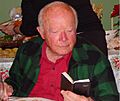Andrew Benson facts for kids
Quick facts for kids
Andrew Benson
|
|
|---|---|

Benson in 2007
|
|
| Born |
Andrew Alm Benson
September 24, 1917 |
| Died | January 16, 2015 (aged 97) La Jolla, California
|
| Awards | Ernest Orlando Lawrence Award (1962) |
| Scientific career | |
| Fields | Biochemistry |
| Institutions | Scripps Institution of Oceanography |
Andrew Alm Benson (born September 24, 1917 – died January 16, 2015) was an important American biologist. He was a professor at the University of California, San Diego until he retired in 1989. Dr. Benson is famous for helping us understand how plants use carbon, a process called the carbon cycle.
Contents
Early Life and Learning
Andrew Benson was born on September 24, 1917, in Modesto, California. His father was a doctor from a Swedish family.
Andrew went to the University of California, Berkeley for his first degrees. There, he learned about light from a scientist named Luis Walter Alvarez. He also worked in the chemistry lab of Glenn T. Seaborg, who was a very famous chemist.
In 1942, Andrew earned his Ph.D. from the California Institute of Technology, also known as Caltech. During this time, he decided he did not want to take part in the war in Europe. This belief caused some challenges for him later.
Working as a Scientist
In July 1942, after finishing his Ph.D., Benson returned to Berkeley to teach. In 1946, he joined a group led by Melvin Calvin. This group was starting to study photosynthesis at Berkeley's Old Radiation Laboratory.
From 1951 to 1952, he visited Norway on a special scholarship called a Fulbright fellowship. He then taught at Pennsylvania State University starting in 1954. In 1962, he moved to the UCSD from the University of California, Los Angeles.
Discoveries About Plants
From 1946 to 1953, Andrew Benson worked with Melvin Calvin and James Bassham. Together, they figured out how plants take in carbon dioxide from the air. This process is a key part of photosynthesis, where plants make their own food.
Their discovery is known as the Calvin cycle. However, many scientists also call it the Calvin–Benson Cycle, or even the Calvin–Benson–Bassham (CBB) Cycle, to include everyone's important work.
In 2002, Dr. Benson wrote an article in the Annual Review of Plant Biology. In it, he looked back at his life and all the scientific work he had done.
Awards and Special Honors
Andrew Benson received many awards for his important scientific work:
- In 1972, he was chosen to be a member of the National Academy of Sciences.
- In 1981, he became a member of the American Academy of Arts and Sciences.
- In 1984, he joined the Norwegian Academy of Science and Letters.
- In 1962, the United States Department of Energy gave him the Ernest Orlando Lawrence Award. This was for his work using special radioactive atoms to understand the carbon cycle.
- He also won the Sugar Research Foundation Award in 1950.
- In 1972, he received the Stephen Hales Prize from the American Society of Plant Biologists. This was for finding ribulose as a product of the carbon cycle.
In 2007, a science magazine called Photosynthesis Research created a special issue just for him. This was to celebrate his 90th birthday.
Dr. Benson was also featured in a TV series on BBC Four in 2011. The series, called Botany—A Blooming History, talked about the history of plants. He was highlighted in the episode about photosynthesis.
See also
 In Spanish: Andrew Benson para niños
In Spanish: Andrew Benson para niños
Images for kids


